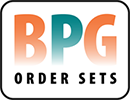The first phase of the BPG Order SetTM Implementation Framework involves three main activities:
- identification of a research-to-practice gap and the associated evidence-based guideline;
- establishment of the governance structure; and
- analysis of the implementation context.
Research-To-Practice Gap & Guideline Identification
Clinical managers, advanced practice nurses (e.g., professional practice leaders, nurse educators and clinical nurse specialists) and frontline clinicians play a key role in the identification of a research-to-practice gap; that is, the gap between current practice and the recommendations in the relevant RNAO best practice guideline. This process typically evolves through one of two scenarios. In the first scenario, the research-to-practice gap is identified through the individual’s involvement in a quality improvement initiative that reveals less than ideal results for one or more key performance indicators. This acts as a catalyst for a review of RNAO’s best practice guidelines for one that may bridge the research-to-practice gap. In the second scenario, the individual(s) may become aware of an RNAO best practice guideline through one of several dissemination channels. This then results in an examination of the existing practices to identify any potential research-to-practice gaps within the organization.
Once the research-to-practice gap has been identified and the decision has been made to address it by implementing a guideline using BPG Order Sets, the organization is ready to initiate a readiness assessment. This assessment is the preliminary step that organizations undertake in analyzing their implementation context. The remaining steps in this multi-faceted analysis are described in detail under Analysis of the Implementation Context.
An organizational readiness assessment is critically important for a successful BPG Order Set implementation. In the context of eHealth, organizational readiness is a multi-dimensional concept that evaluates individual, organizational, and technical readiness. A well-executed readiness assessment can:
- provide objective information about the organization’s knowledge, resources, and capacity to succeed;
- elicit valuable information concerning the perception of end users and other key stakeholders; and
- identify areas for improvement that will need to be addressed to ensure success.
More detailed information on the topic of organizational readiness is available in the Tools & Resources section and in the RNAO eHealth guideline: Adopting eHealth Solutions: Implementation Strategies (p.33).1 An organization that is considered ready to begin the process of implementing the BPG Order Sets can proceed to the second major activity required during this phase. This is the establishment of the governance structure.
Establishment of the Governance Structure
The establishment of a formalized governance structure to support the BPG Order Set implementation is a top priority. In this context, governance refers to the “leadership and organizational structures and processes to ensure that the strategic direction, goals, and objectives” (p. 8) of the project are met.2 An effective governance structure is required to oversee and guide the design, implementation, and adoption of the BPG Order Sets. A strong governance structure supports decision making, strengthens the alignment between the BPG Order Set implementation project and other organizational priorities, and enhances end-user engagement and acceptance. There is no one-size-fits-all governance structure.1
A project manager/lead should be identified at this stage of the project. Given the complexity of the BPG Order Set implementation, the project should ideally be led by a project manager with expertise in project management methodology. In smaller health care organizations, this role may be assumed by a project lead.
During this phase, the project manager/lead should identify the membership of the project team in conjunction with the project steering committee. It is critical for the project team to be comprised of individuals with the required competencies to lead and support the BPG Order Set implementation. Collectively, the project team should possess the following competencies:
- in-depth knowledge of all stakeholder workflows;
- informatics knowledge and skills to integrate the BPG Order Sets within the organization’s electronic health information system;
- ability to develop and communicate key messages to all stakeholders and obtain their feedback;
- facilitation skills to conduct staff education and training; and
- in-depth knowledge of the new stakeholder workflows to provide support during and after the implementation.
A project charter is required as part of the project initiation process to clearly define the deliverables and formally authorize the project manager to proceed with the project. The project charter is typically written by the project manager/lead with input from other sources including, but not limited to, the project sponsor and subject matter experts.3 A project charter template is included in the Tools & Resources section as well as information on the sector-specific governance structures that were used by the partner organizations during the RNAO Nurse Peer Leader Network Project.
Analysis of the Implementation Context
Effective analysis of the implementation context at the outset of the project can positively influence the overall project success. The purpose of this analysis is to gain an in-depth understanding of the environment in which the BPG Order Set will be deployed and the stakeholders who will be impacted. The four main objectives of this analysis are to:
- identify current practices that are inconsistent with the evidence-based guideline recommendations;
- identify and analyze all stakeholders who will be impacted by the BPG Order Set implementation; and
- understand the workflows of the stakeholders.
Three major activities occur during the analysis of the implementation context: gap analysis, stakeholder analysis and current state workflow analysis. Each of these activities is described below:

